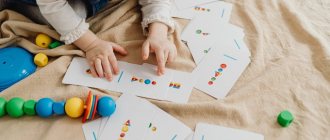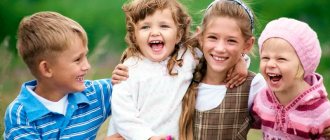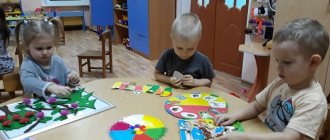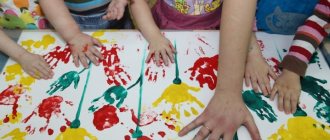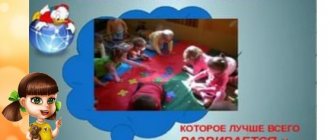Progress of the game.
The teacher scatters multi-colored balls on the floor, selects one ball, and asks the child to pick up the same one. Example: “I take a green ball, and you show the same ball.”
.
5. Game "Color Path"
.
Didactic task. Strengthen ideas about six colors, find identical colors using geometric shapes.
Material. Large multi-colored circles cut out of colored paper, as well as small squares.
Progress of the game. We lay out a multi-colored path. The distance between circles should be at least 50 cm.
The teacher shows and gives the child a card, for example, green, the child finds a green circle and places a card of the same color on it.
6. Game “Colored Train”
.
Didactic task. Give children the idea that color is a sign of a variety of objects and can be used to designate them.
Material. Construction set and small animal figurines.
Progress of the game. We build a steam locomotive from a construction kit. Each carriage is a specific color.
The teacher invites the child to put the horse in the blue carriage and the duck in the red carriage.
Form standards.
Standards of planar and volumetric geometric shapes.
(10 classes)
Goal: to teach children to distinguish and name geometric shapes
1. Game “Pick up a figure”
.
Didactic task. Strengthen children's about geometric shapes and practice naming them. Learn to select shapes according to the model. Strengthen the skill of examining geometric shapes using the technique of tracing and overlaying.
Material. Demonstration: circle, square, rectangle, oval, triangle cut out of cardboard. Handout: cards with outlines of five geometric shapes, one shape of each shape of the same size as the outline images on the cards.
Progress of the game. The teacher shows a circle and, tracing it with his fingers, asks: “What is the name of this figure, what is its shape?”
Shows an oval, also tracing it with his finger:
“What shape is this?”
He does the same with other figures in the following sequence: triangle, square, rectangle.
While tracing the figures, he fixes his attention on the corners. children's inaccurate and erroneous answers .
“You have cards on your tables with figures of different shapes on them, and the same figures on trays. Lay out all the figures on the cards so that they match the ones drawn.”
2. Game “Match by Shape”
.
Didactic task. Teach children to identify the shape of an object, distracting from its other features: color, size.
Material. Demonstration: one large figure of each of the five geometric shapes. Handout: cards with outlines of geometric figures; two figures of each shape of two sizes of different colors (the large figure matches the size of the outline image on the card).
MAGAZINE Preschooler.RF
Sensory education of young children using educational gamesA child’s sensory development is the development of his perception and the formation of ideas about the external properties of objects: their shape, color, size, position in space, as well as smell, taste, etc. The importance of sensory development in early and preschool childhood can hardly be overestimated. It is this age that is most favorable for improving the functioning of the senses and accumulating ideas about the world around us. Sensory education, aimed at ensuring full sensory development, is one of the main aspects of preschool education.
Sensory development, on the one hand, forms the foundation of the general mental development of the child, on the other hand, it has independent significance, since full perception is necessary for the successful education of the child in kindergarten, at school, and for many types of work.
Knowledge begins with the perception of objects and phenomena of the surrounding world. All other forms of cognition - memorization, thinking, imagination - are built on the basis of images of perception and are the result of their processing. Therefore, normal mental development is impossible without relying on full perception.
The origins of sensory abilities lie in the general level of sensory development achieved in early childhood. The importance of a child’s sensory development for his future life confronts the theory and practice of preschool education with the task of developing and using the most effective means and methods of sensory education in kindergarten.
In addition, throughout the life of children, sensory experience is accumulated, their worldview is enriched, emotional tone is increased, positive emotions associated with the perception of environmental phenomena are activated, interests are aroused, and needs are formed.
Sensory education in the learning process and in everyday life requires different ways and methods.
1. Sensory education of young children through perception.
The sensory development of younger preschoolers occupies one of the central places in working with them. This age is most favorable for the development of a child’s perception, improvement of his senses, and accumulation of ideas about the world around him. The sensory development of a child, on the one hand, has independent significance, since it provides clear ideas about the environment, and on the other hand, it forms the foundation of the child’s overall mental development.
Sensory education in the younger group involves the development of general sensory abilities, understood as the ability to the most elementary form of mediation - the use of sensory standards. Sensory standards are generally accepted examples of the external properties of objects. In sensory education classes, the child gets acquainted with such patterns as color (red, yellow, green, blue), geometric shape (circle, square, triangle, rectangle), size (large, medium, small).
In mastering sensory standards as a means of perception, several stages can be distinguished:
- Stage – the emergence of object pre-standards, when when perceiving one object another is used as a model (for example, triangular objects are called roofs). This usually occurs in the third year of life. The subsequent stages are typical for the fourth year of a child’s life.
- Stage – transition from the use of pre-standards to the use of standards themselves; the means of perception are no longer specific objects, but samples of their properties (primary colors, geometric shapes, size).
- Stage - a more subtle differentiation of assimilated standards: familiarization with shades of color tones, variants of geometric shapes, and individual parameters of size.
The process of developing sensory abilities includes not only the assimilation of standards, but also actions to use them.
There are three types of activities for using sensory standards, i.e. perceptual actions. The simplest ones are identification actions, i.e. establishing the identity of any quality of a perceived object with a standard.
The most difficult actions for preschoolers are those associated with the need to independently analyze the complex properties of objects, “decomposing” them into elements that correspond to the learned standard ideas, followed by the reconstruction of the whole object.
The development of a preschooler’s sensory abilities is concentrated in one age stage, in the second younger group, since numerous studies have proven that this period of a preschooler’s life is the most sensitive for the development of perception. Sensory tasks are usually included in activities that children find interesting (play, experimentation, productive activities). Here children are faced with the need to highlight one or another property of an object, which is significant for the successful implementation of this activity. In other words, children themselves become interested in mastering standards, since knowledge of standards determines the success of gaming or practical activities. With this approach, children gradually develop their own cognitive interest, which replaces play interest. As a result, the child begins to use standard representations to analyze the properties of objects in a variety of situations. In other words, having mastered sensory standards, children can use them as “units of measurement” when assessing the properties of things.
In classes on sensory education, tasks are solved to develop the initial forms of cooperation between children and each other. This is one of the necessary conditions for activating the cognitive interest of preschoolers. Children are offered special tasks, during which they enter into a relationship of cooperation - coordination and subordination of actions. Younger preschoolers can interact with each other in pairs when working with familiar material. There are two main types of cooperation: by role (function) and by rule (alternation of actions, separation of operations, etc.).
1. 1 Sensory perception of color.
A baby is born with ready-made sense organs: he has eyes, ears, his skin has sensitivity that allows him to touch objects. But all these are just prerequisites for perceiving the world around us. Sensory education is designed to teach children to accurately, fully and clearly perceive objects, their various properties and relationships. Psychological research shows that without such influence, children’s perceptions for a long time remain superficial, fragmentary and do not create the necessary foundation for general mental development.
The perception of color differs from the perception of shape and size, primarily in that this property cannot be isolated practically through trial and error. Color must be seen, that is, when perceiving color, you can only use visual orientation.
First, measuring and comparison by application play an important role in determining color. When two colors are closely adjacent to each other, it is not difficult for a child to detect their similarity or dissimilarity. At the same time, he may not yet have the perception of color, he may not know that both objects are red or one of them is red and the other is yellow, but he will see that the colors are the same or that they are different.
When the baby learns to identify colors when they are in direct contact, that is, by overlay and application, you can move on to the task of choosing from a pattern (to the real perception of color), and then to teaching him the names of colors.
Based on the perception of color, corresponding ideas about it are formed. Thanks to this, children can not only use color in their activities (art, work), in play, but also use it as a signal for action in everyday life (for example, understand traffic light signals).
The color characteristics of didactic material are especially important. Color is characterized by two dimensions: lightness and purity. It can be dark or light (although they are the same color). The second dimension of color is its purity, which depends on the admixture of gray. The slightest admixture of gray makes the color “dirty” .
When selecting didactic material, it is also necessary to strive for the same color saturation. If the red color is bright, then orange, yellow, blue, etc. should be equally saturated and bright. Otherwise, a child with color vision impairment may focus not on the color itself, but on its intensity. Then he will classify light red and light green objects as one group, and combine dark red objects with dark blue or dark green.
Teaching aids that are correctly selected in color, shape, and size carry a great emotional charge.
1. 2 Sensory perception of shape.
Shape is one of the main characteristics of an object. Without isolating and identifying the form, it is impossible to recognize the object.
The simplest types of distinguishing objects by shape become possible for children very early, at the age of several months. But throughout childhood, the perception of form undergoes a number of significant changes.
A child’s actions with real things in the world around them begin in infancy, but during childhood they change significantly and become more complex, becoming meaningful and purposeful. As the child ages, he moves from primitive actions such as manipulating an object to more complex, so-called productive activities: modeling, drawing, designing, etc.
The profound qualitative changes that occur throughout childhood in the visual perception of a form consist in the fact that the child gradually moves from primitive forms of analysis of a figure, consisting of isolating its individual component parts, to a more complex analysis of objects, consisting of comparison, juxtaposition of the perceived object ( whole or its individual parts) with other objects or with the proposed sample.
In particular, the constructive activity of children has a great influence on the development of visual analysis of form. Construction practice for preschoolers usually involves working with some kind of building material. Typically, two types of constructive activity in preschool children are noted:
- Free construction is a construction in which the child is not bound by any external model: the child has the opportunity to build whatever he wants from the available material. In the process of such construction, the child can repeatedly change his plan and combine individual elements as he pleases.
- Design based on a sample. As a sample, the child receives a drawing on which the contours of all the elements that make up the image are indicated. Since the contours of the shape, color and location of individual elements are indicated, the child’s task in this type of construction is to reproduce in his own design what is shown in the drawing. This type of independent activity is rare and usually occurs only in classes.
The practice of designing according to a model alone is not enough to form the same quality of perception as visual analysis of the form. To develop perception, it is necessary to organize the child’s practical activities and confront him with the need to analyze the proposed design according to form.
Research has shown that the processes of perception that take place when analyzing the shape of an object can be considered as a kind of indicative actions that serve practical actions and are in complex relationships with them. Initially, at lower stages of development, these indicative actions are closely related to practical, performing actions, then, in the process of development, they move more and more away from performing activities and develop into a relatively independent system of indicative-research activities, with the help of which preliminary familiarization with object, examining it and preparing for practical actions with it.
Thus, actions with an object direct the development of perception, but, becoming more and more accurate, perception, in turn, performs an orienting and regulating function in relation to practical actions. The close relationship and interdependence of both of these parts of the action - the orienting and the executing - indicates the need for attention to each of them.
The nature of orientation-research activity changes throughout childhood. Movements to examine an object from disorderly and chaotic gradually become more purposeful and systematic. At the same time, the main role in the examination process begins to be played by the eye, and not by the hand, as it was before. Thanks to this, the action becomes faster. However, as research shows, without special training, a child learns quite late to correctly compare the individual, most characteristic features of a figure with each other and, based on them, correctly find a shape among others.
Only by the age of four do children learn to do basic things according to a model. This suggests that complex analysis, which consists of comparing objects, remains for a long time in preschool children at a relatively low stage of development.
Observations of children's actions during construction show that initial orientation in conditions also occurs with the help of external actions with objects or their substitutes. So, before constructing, the child examines and feels the object. Thus, he, as it were, simulates the subsequent practical solution of the problem.
However, not always and not all children perform such actions correctly and well. Therefore, the process of mastering visual analysis of a figure in natural conditions, without special training, proceeds unevenly and with a large number of errors. But if the modeling of a perceived object does not develop spontaneously, but under the systematic guidance of an adult, and if the child is given adequate means and methods for such modeling, then it can reach a significantly higher level of development and on its basis the child can develop adequate techniques of purely visual analysis of complex shapes.
If preschool children are purposefully taught how to analyze a figure, giving them certain tools for this, then the ability to analyze complex forms, isolate individual elements in them, and on this basis carry out design according to a model appears in the child much earlier and is formed at a much faster pace.
1. 3 Sensory perception of size.
The perception of size is of a special nature. Since quantity is a relative property, its precise determination is made using conditional measures. The difference between these measures and geometric forms lies precisely in their convention. The system of measures is consciously established by people, and in principle any arbitrary unit can be taken as a basis, while geometric figures are a distraction from the shape of real objects. Mastering a system of measures and how to use them is a special task that requires certain mathematical preparation and is not included in the preschool education program. But in the field of perception, we do not always use the metric system (although its use is quite possible).
The size of an object is usually determined depending on the place it occupies in a series of similar objects. So, a big dog is a dog that is larger than most other dogs. But at the same time it is much smaller than a small elephant. Thus, as standards of size I use ideas about relationships in size between objects, denoted by words indicating the place of the object among others ( "big" , "small" , "largest" , etc.). The complication of these ideas lies in the gradual transition from the comparison of two or three objects to the comparison of many objects, forming a series of decreasing or increasing values.
When comparing objects by size, the eye develops. To improve eye measurement, it is necessary to teach children to solve increasingly complex eye problems. A simple eye task, accessible to three-year-old children, is to select by eye a larger (or smaller) object out of two, then select an object according to a pattern (when out of two objects you need to choose by eye the one that is equal to the third). It is even more difficult to perform an eye “addition” - to select two objects by eye, which in their total size are equal to the third. Finally, during preschool age, children can learn to measure by eye not only the sizes of individual objects, but also the relationships between them, i.e. master visual assessment of proportions.
In the process of teaching children how to examine the size of objects, it is useful to teach them to use the simplest measure, which acts as an intermediate means in the transition from applying comparable objects to each other to eye action. So, choosing an object equal to the sample, the child measures the sample with a strip of paper, and then uses this measure to find an object of the required size. Mastering actions with measurements leads children to the subsequent use of a generally accepted system of measures.
2. Formation of experience.
As experience shows, it is necessary to begin the process of developing sensory education from an earlier age, from 2–4 years.
Based on the results of diagnostics and questioning of parents, it turned out that some children are significantly ahead of their peers, they are curious, inquisitive, show great interest in the new, unknown, while possessing a good amount of knowledge. Working with parents, it turned out that children are given a lot of attention at home, they study with them, and listen to the teacher’s recommendations.
Such children, after a short period of work, rise to a higher level, training their intellect in play activities.
To do this, it is necessary to create a good environment that best meets the child's needs. For experimental purposes, you can use Game technology for the intellectual and creative development of children. V.V Voskobovich “Purple Forest” .
“Purple Forest” is a kind of fairy-tale space in which each game has its own area and its own hero. Through play, children develop sensory experiences.
Taking into account the psychological characteristics of young children (the beginning of the formation of children's relationships), a large role should be given to play - the role brings children together when working in pairs and groups. The result is obtaining joint results of activities, this is necessary for the personal development of children.
| Next > |
Progress of activities.
Q: “Guys, I think someone is knocking at the door?
Who is this? (He goes out and brings
a letter and a parcel to the group ) .
- “Look, here is a letter! Grandfather Frost writes to you: “In order to receive gifts from me, you must complete all my tasks.”
Task one.
Q: Remember and expressively read a poem about winter or a Christmas tree (Reading one or two poems in chorus, then at the request of the children ).
Q: “The chest doesn’t open. There is one more task to complete."
.
Second task.
There are 2 streams on the floor.
Q: “Look guys, these streams are covered with ice! Why? ( children's )
That's right, water freezes in winter.
Are the streams the same width? Show a wide stream, and now a narrow one. Let's step over the wide stream (children take a big step)
.
Now let's cross the narrow stream (children take a small step)
.
- “Why did we first take a big step and then a small one?”
(Encourage
children to use words wider - narrower) .
“Did you complete the task? Let's try to open the parcel. It still won't open."
Task three.
Q: “Look, guys, there’s some kind of image on the parcel. What is this?"
Children: “Christmas trees”
.
Q: “Are they the same or different?”
(
children's ) .
Q: “Christmas trees are big and small. Let's assemble a tall Christmas tree first. What geometric shapes will we use?
Children: “Big green triangles”
.
Q: “Now low. What geometric shapes will we use?
Children: "Little green triangles"
.
Q: “Which Christmas tree is taller? Which one is lower? Let's play. You and I will be Christmas trees. Draw a tall Christmas tree, and now a low one. Did you complete the task?"
Children: "Yes"
.
Q: “The parcel won’t open”
.
Task four. “We need to color the cards”
.
Q: “What is this?”
Children: "Mittens"
.
Q: “One mitten is painted, but the other is not , we need to correct the mistake, can you?”
D: “Yes!”
B: “Let’s fix it!”
Q: “Did you manage everything?”
D: “Yes!”
Bottom line. “What did we do to open the package?”
(
Children's ) .
The package is opened - the children find gifts from Santa Claus - sweets.
2. "Matryoshkas - neighbors"
.
Goal: Development of sensory abilities in children of primary preschool age.
Tasks:
Educational.
1. Develop the ability to compare objects of contrasting size and width.
2. Develop the ability to denote the results of comparison with words: high - low, wide - narrow.
3. Strengthen the ability to distinguish and name colors.
Developmental.
1. Contribute to the development of conversational communication during the lesson , develop spatial orientation.
3. To promote the development of various activities of children during educational activities.
Educational.
1. Cultivate such moral qualities as the ability to be friends and come to each other’s aid.
Integration of educational areas.
- speech development ,
- artistic and aesthetic development ,
- physical development ,
- cognitive development ,
— social and communicative development .
Demonstration material: 2 nesting dolls (large and small, 2 houses (large and small), 2 Christmas trees (large and small, 2 baskets, 10 mushrooms (5 large and 5 small), ribbons (short and long, flowers made of colored paper.
